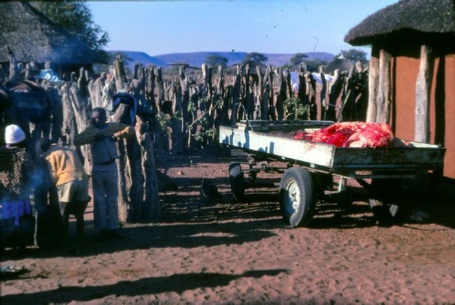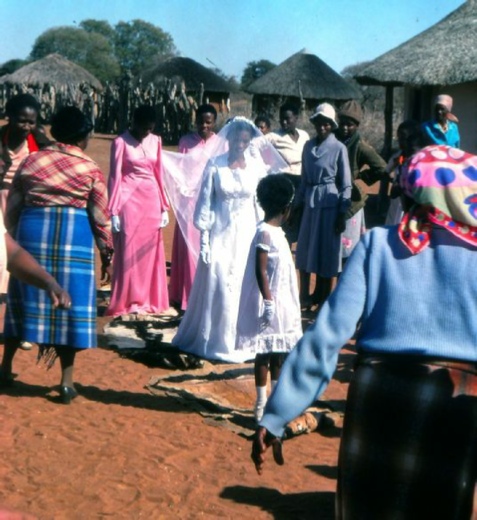© 2018 Dr Margaret Sheppard
A Mobirwa and Matebele Wedding 1982
This non-
As it will be noticed that quite a few of the practices differ from Bangwaketse weddings. The bride was a Mobirwa -
The bride and groom had met through their church, the Seventh Day Adventist Church (S.D.A.), to which both families belonged. The couple both worked away from their homes, the bride in Kanye and the groom in Gaborone.
The part of the wedding observed was that at the bride's home. As both families belong to the S.D.A. church the wedding was celebrated on the Sunday of a Public Holiday long weekend. On the Saturday all wedding preparations had been suspended because of the strict Saturday Sabbath observance in this church.
The bride had arrived the previous Tuesday and since then. apart from attending church on the Saturday. had been confined inside one of the houses in her family yard. This, she told me. is a common practice in the Bangwato area -
After sunset on the Saturday the cooking and preparations continued throughout the night and a cow provided by the bride's family for the feast was slaughtered.
Early on Sunday morning we were all given the special stemped backbone meat. (Among the Bangwaketse this meat is only eaten by the men.)
Just after sunrise men from the groom's family arrived to ask for a bride. As in this village there are no family dikgotla they came into the lolwapa of one of the houses in the yard. They knelt down to make their request. They were then served with refreshments. The cow they had sent for feeding their family at the feast was slaughtered (In fact they had sent money for one to be purchased locally as they came from so far away.)
Bride appears walking on skin mats to gate of yard and then to depart to the church
The bride and the bridesmaids walked all the way from the house to the car which was at the entrance to the yard, on two skin mats. These mats were put in front of each other alternately so that their feet never touched the ground.
Back from Church
After the service all returned to the bride's home, the bride and groom rode together in the same car, which was decorated with streamers.
Outside the yard the bridal procession were joined by the groom's male relatives, who entered dancing and singing a Sindebele wedding song. They danced all round the yard. surrounding the couple and at times threw some mabele (sorghum) over the bride -
Bridal Party on “show” and eating feast
The house where the bride was secluded
The shaded seating for the guests and bridal couple for the formal speeches.
Washing up
Arrival of Groom’s female relatives with bridal clothes and to dress the bride
At about 9.00 a.m. The ladies from the groom's family arrived with the wedding dress and the change dress the groom's relatives provide for the bride. These clothes were packed in suitcases. They entered in a line. and were taken to the house where the bride had been concealed.
They were also served with refreshments.
The female relatives of the groom dressed the bride and the bridesmaids (2 adult ones who wore pink and a child in white). At about 11.30 a.m. the groom's relatives brought the bride and the bridesmaids out of the house.
Next we all drove to the church, where we met the groom’s procession. Here there was an S.D.A. marriage service. An American "romantic" love song was played, during which the best man, groomsmen, groom the bridesmaids and finally the bride entered in time to the music. The couple then took their marriage vows and were married by the Priest.
Groom’s attendants sang and danced Sindebele wedding songs whilst casting the mabele (sorghum) over the couple
Other guests are served and socialise. N.B men and women sit separately
After this the bridal party were seated with special relatives in the shaded area in the yard, and the feast was served to them by the bride’s female relatives and neighbours.
Everyone else was given plates of food.
Some S.D.A. trios, quartets, quintets etc. sang S.D.A. hymns to the couple as they ate.
Unfortunately I had to leave to catch the train and buses back South at this point, but the bride later told me that she was taken to the groom's home that night by his relatives.
One of her sisters accompanied her there and remained with her there for a few days.
Her feet never touched the ground as she walked on the skin mats to the waiting car
Wedding Preparations
The bride’s female relatives had repaired and decorated the houses and yards of the homestead for the wedding


The yard and stoep had been newly smeared with cattle dung and formed into intricate patterns
The whole yard was swept


The meat provided by the groom’s family for the feast
Men of bride’s family preparing the backbone for the special meat eaten by all. After they have cooked it they stemped it -


Family dogs awaiting their share
Water had been fetched from the borehole and stored in drums for all the cooking and washing


Preparing the wedding feast. Men cook the meat and women prepare the rice, maize meal porridge, vegetables and salads and desserts







Groom’s female relatives arrive to dress the bride
The wedding dress and veil are in the suitcases


The bride exits the house where she was attired by groom’s female relatives, led by the flower girl














After eating they were led by the Matebele men dancing and singing the same Sindebele song, into a lolwapa where they sat for some time, before going to dress in their change clothes.
